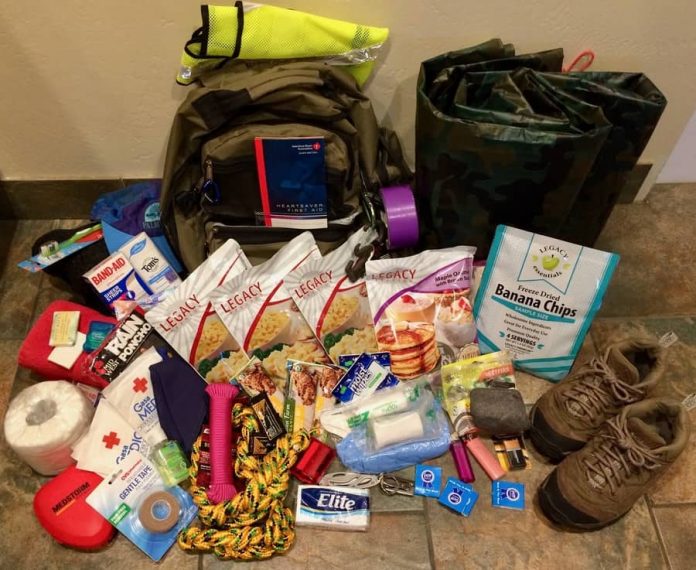Before you begin making a checklist of items to go into the expanded 72-hour emergency disaster kit, throw on your existing bag, and go for a hike – a real hike, not a casual stroll around the block.
Unfortunately, many preppers have never really tested out their bugout bags and will be shocked at how heavy the burden be when it comes time to put them on and maneuver through a dangerous situation like they actually depend on it.
How Heavy Should a 7-Day Bag Be?
If you haven’t already, weigh your bugout bag both empty and filled with its current contents. Next, strap that bad boy on and go for a five-mile hike. You may be walking or hiking a whole lot longer than that during a SHTF situation, but this will at least provide a realistic idea of how much weight both your bag and your body will be able to consistently withstand.
Replicate the terrain you will most likely have to traverse to get home or to your survival retreat as closely as possible during the test run. Record how long it takes you to hike the five miles to better gauge your travel time during a disaster situation.
The average person can walk at a sustained 2.5 to 3 miles per hour for at least three miles on flat and even terrain. The weight of the bag is likely to slow you down somewhat, depending upon your regular preparedness physical fitness routine. How long it is likely to take you to arrive at your destination will greatly impact the number and type of survival items you pack in the 7-day bugout bag.
Now, take the exact same hike once again by adding between five to seven pounds of weight to the 72-hour bugout bag. Use labeled hand weights or cans of food or similar items that you weigh before putting them in the bag. This will help you determine both how you handle the additional weight during a trek and how much extra space is available in the bugout bag.
Even if can handle the additional weight easily, think long and carefully before rushing out to buy a bigger bag simply because you are in great shape and want to pack as much “stuff” as possible. The bigger the bag, the more unwanted attention it will attract. The worst-case scenario in a SHTF situation is not having a little less than what you need in the bag, but having it taken from you and being left with absolutely nothing.
The bugout bag should be as inconspicuous as possible. The bright red bags sold on many websites that offer emergency gear are really pretty, but click on past them and do NOT put one in your virtual shopping cart. The best, meaning most stealthy, bugout bags are dark in color, navy blue, black, brown, or better yet – camo!
A rucksack built upon a lightweight yet sturdy frame will help balance the weight of the filled bag and save intensive wear and tear on both your upper body and your lower back. You do not want to have suffered a pinched nerve, stretched muscle, or slipped disc during a doomsday disaster – that would make you a few steps too slow and an easy target for potential attackers.
Top 7 Survival Must-Haves for a 7-Day Bugout Bag
- 2 Life Straws – put two of these in an outer zipper pocket of the bag. Remember, one is none and two is one. They are lightweight and take up very little space, keeping a second straw in case the first one breaks, gets lost, or is used for barter only makes good sense. Also, pack a collapsible water bottle, they are typically sold with a clip so it can be attached to a belt or the bugout bag.
- 1 Dozen Emergency Water Pouches – These individual water pouches resemble the CapriSun drinks used for children’s lunchboxes. They are lightweight and durable and will provide extra emergency water if using the Life Straw is no longer an option.
- 7 Mylar Blankets – All seven of these blankets will take up significantly less space than a single wool blanket – and weigh far less. Blankets get damp and cold and the Mylar emergency blankets will not. After a single-use, they can be pitched or used as a base or roof for a temporary shelter or wrapped around boots to protect them from the elements.
- 21 Nourishment Bars – Packing some MREs or more gourmet style long-term storage food in a bag kit will provide a nice hot meal, but they require extra space for themselves and the necessary preparation and eating materials. Place them in your 7-day bag if you can, but stockpile protein, fruit, granola, and breakfast bars for all but one of the three daily meals to conserve space. Beef jerky or jerky and cheese combo packets can also be used to boost calorie intake without taking up much space or weight.
- Portable Stove or Rocket Stove – A homemade metal can rocket style stove or other lightweight and portable survival stove that is readily available to buy from a preparedness retailer. Whether or not you will be cooking food, you may need to sterilize first aid tools, purify water, or use the heated water to ward off frostbite or hypothermia.
- Folding Shovel-Hatchet – The portable and relatively small, but not lightweight tool are sold at survival and Army surplus stores. They typically come in a hard pouch that can be affixed to a bugout bag or a belt. They can be used to dig latrines, chop firewood, chop wood to make traps, and as a silent weapon.
- Cookware – Purchase a self-contained Army surplus or camping cookware set. The kits weigh only about a pound at most and function as a deep skillet, plate, and allow for the firm attachment of the provided stainless steel mug and fork-spoon combo.
The remainder of the 7-day bugout bag would include all the standard essential survival gear that was stored in your 72-hour bag, as space permits. Wearing a paracord bracelet (or 2) on your wrist, your knife, and extra ammo on your belt; and using a headlamp or a flashlight that clips onto the bugout bag will not save you from packing extra weight, but will safe a sizable amount of space in the emergency disaster bag.





















